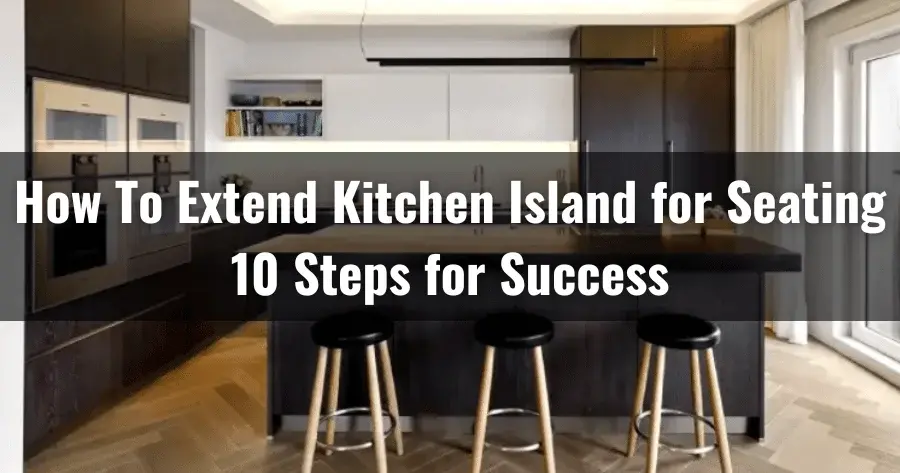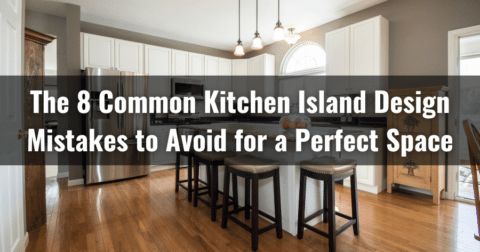Are you looking to add more seating space in your kitchen? One solution is to extend your kitchen island. Not only does it provide additional seating, but it can also enhance the functionality and style of your kitchen.
But how to extend kitchen island for seating with all the options available?
Identify your goals for the extension. Do you need more counter space, more seating, or both? The next step is to determine how many seats you want to add.
You should also consider the size of your kitchen and the available space around the island. Consider dimensions carefully and select materials that will complement your existing décor.
Here we discuss how to expand your kitchen island for seating with seat space ideas and whether small kitchen islands are good or bad. Let’s get started.
Jump to Section
10 Steps on How Can You Extend Kitchen Island for Seating

You should take the below steps to ensure the end result is functional and aesthetically pleasing when you’re extending your kitchen island.
Here are the 10 key steps to keep in mind:
Now, let’s get started on transforming your kitchen into a more inviting and comfortable space!
Step 01: Determine Your Goals
Consider whether you want to increase seating capacity, add more counter space, or both when you extend your kitchen island. The average homeowner spends over an hour a day in the kitchen, so it should be comfortable and functional.
Step 02: Assess Available Space
Before making any additions to your kitchen island, take a moment to assess the available space. It’s essential to consider factors such as traffic flow and clearance requirements to ensure the best outcome.
When adding seating to your island, having ample room to move around is a must. Make sure to avoid creating a cramped or obstructed space.
Step 03: Consider Island Dimensions
When extending your kitchen island for seating, consider the dimensions carefully. A comfortable length for accommodating four counter stools is approximately 10 feet, so remember this guideline when planning your island extension.
You want to ensure enough length and width to comfortably seat your guests at the extended portion of the island. Also, think about the height of the seating area and ensure that it’s at a comfortable level for sitting and eating.
Step 04: Choose an Extension Method
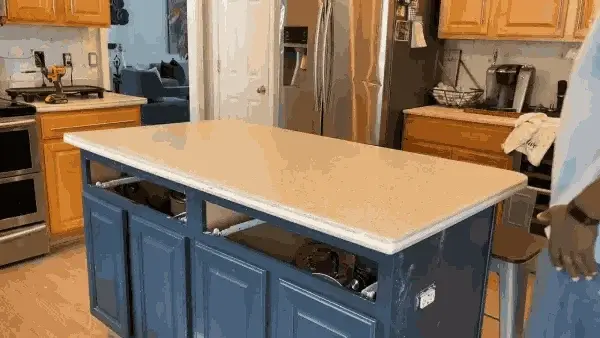
There are multiple ways to extend a kitchen island for seating. Some common options include:
1) Adding Another Level
Incorporating a second level above the existing countertop can easily create a more functional and visually appealing kitchen island. This method adds extra seating and creates a clear separation between the cooking and dining areas.
2) Incorporating a Standalone Island Extension
With this option, you can create more counter space and seating while maintaining the flow of your kitchen’s layout. To create contrast in your space, you can choose materials, colors, and finishes that complement your existing island.
3) Butt a New Work Surface
Another option is to put a new work surface to one end of the existing island. This approach adds counter space and seamlessly transitions between the two surfaces. This extension will make your kitchen island even more functional and welcoming, whether you’re hosting a dinner party or preparing meals.
4) Adding a Table
Extending the kitchen island with a table allows you to create an open-concept layout perfect for cooking, eating, and socializing in one space. Consider both the size and shape of the island and your kitchen when selecting a table to complement the existing design.
5) Adding Butcher Block to One End
A butcher block is a great option for extending your island because it’s durable, easy to clean, and adds warmth to the space. It’s perfect for food prep or serving meals family-style. Ensure the butcher block extends beyond the countertop so you have enough room for seating when choosing the right size.
Step 05: Determine the Materials to Extend Island Portion
When deciding on materials for your island extension, consider options such as sleek granite or sturdy laminate. These materials offer both style and durability, just like a trusty old friend. You may also want to consider wood or quartz for their natural beauty and design versatility.
You can choose materials that complement your existing kitchen island based on your extension method and the look you’re going for. For instance, opt for a matching wood tone if extending with a table or butcher block.
Alternatively, if adding another level of countertop space, choose a similar material to your existing island. The key is to create a cohesive design while also giving the nod to your individual style.
Choosing materials that can withstand your household’s demands is also essential. Materials that can resist spills and stains may be ideal for households with children.
Step 06: Prepare the Workspace
Get ready for the transformation of your cooking space by prepping the workspace with all the necessary tools and materials. Start by clearing off any items from the existing island and removing any trim if necessary.
Ensure you have all the required tools, such as a saw, measuring tape, drill, screws, and sandpaper. Depending on your design plans, you’ll also need to purchase or gather additional materials, such as wood planks or countertop materials.
Step 07: Extend the Island Structure
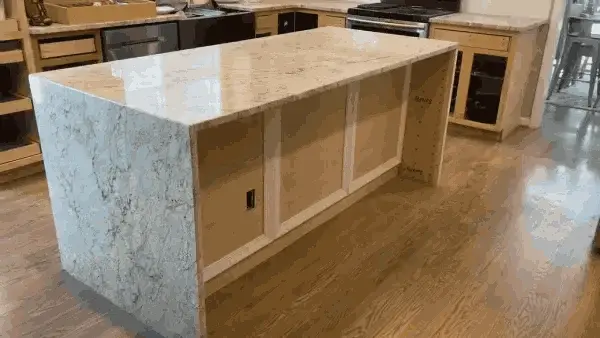
As you expand your culinary kingdom, consider reinforcing the heart of your domain with additional support structures.
Building or installing legs, cantilever countertops, or additional base cabinetry is crucial when adding another level or an extension. This will ensure proper reinforcement and stability for any new additions to your island.
Step 08: Install Additional Seating
Adding counter stools or chairs that match the style of your kitchen will provide ample seating for family and friends. You should consider the height requirements of your island extension when choosing stools or chairs for additional seating.
Look for options with sturdy bases and durable materials that can withstand daily use in a busy kitchen. Seating should also suit the overall aesthetic of your kitchen, whether it’s a modern, minimalist look or a more traditional one.
Step 09: Electrical Considerations for Extended Island
The extended portion of your island needs electrical outlets and switches to bring your kitchen to life. This is especially important for appliances that require electricity. To ensure safety and compliance, consult a professional electrician before beginning your DIY electrical project.
They play a key role in preventing dangerous situations such as electrocution and electrical fires. Having an electrician assess your current electrical system can help you decide how to expand it into the kitchen island.
Step 10: Finishing and Painting The Island Surface
After making any repairs and smoothing the surface, use a high-quality primer to prevent stains from bleeding.
If the extended material is wood, fill any gaps or holes with wood filler and sand smooth after priming. In the case of granite or laminate, siliconizing is the best option for filling any gaps or holes.
Caulk around the edges of the island to create a seamless finish. For a durable finish, select a paint color that complements your existing cabinets and walls.
How many seats can the kitchen island accommodate?
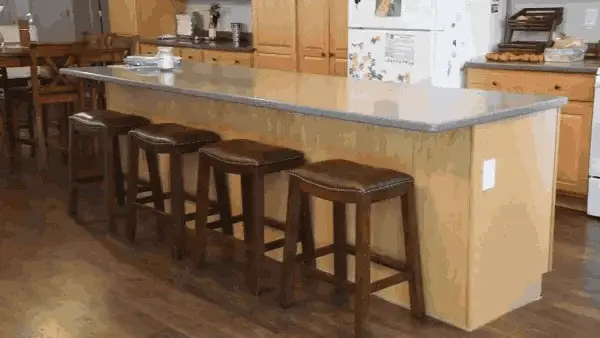
You’ll be able to comfortably seat a specific number of people at your kitchen island by simply dividing its counter length by 30 inches. Home experts recommend allowing 28 to 30 inches for each seating space.
This means you should measure the length of your island’s counter and divide it by 30 to determine how many stools will fit. Remember that this calculation is based on providing enough space for comfortable seating, so leave the area manageable.
Can a kitchen island be too small?
You should choose something other than a giant island in your kitchen, as it can look lost and take up valuable countertop space. A small island may also need more seating space, leaving you with limited options for guests or family members to sit and socialize while you cook.
Also, a cramped kitchen island poses a safety hazard, causing people to bump into each other or knock over items on the counter. So, when selecting a kitchen island, ensure it’s the right size for your space.
Maximizing Your Kitchen’s Potential: Expand Your Island for Functionality and Style
If you’re looking to maximize the potential of your kitchen and create a functional and stylish space, consider expanding your island. It provides a central hub for social connection, enhances the functionality of your kitchen, and can serve as a stylish focal point in your home.
Not only will it provide you with more countertop space for preparing meals, but it can also serve as a dining room table or eating area.
By extending an island, you can add more storage options, such as cabinets or drawers, allowing you to declutter your kitchen and keep everything organized.
Additionally, you can incorporate a stovetop into your new island, making it a centralized cooking station.
To enhance the style and aesthetics, consider adding a bar top to the extended island, which can function as a casual eating space or a place for guests to gather during social events.
How Much Does It Cost To Extend a Kitchen Island?
When considering the cost to extend a kitchen island, there are a few factors to take into account. Firstly, you need to think about the current space in the kitchen and how much you want to extend the island.
Larger extensions will naturally incur higher costs due to additional materials and labor. Secondly, the materials you choose will also impact the overall cost. For example, opting for high-end materials like granite or quartz countertops will drive up the price.
Additionally, consider any extra features or appliances you may want to incorporate into the expanded island, such as a sink or a built-in cooktop. These add-ons will increase the overall cost.
It is essential to hire a professional contractor to ensure a successful and safe expansion. The labor costs will vary depending on your location and the complexity of the project.
All in all, while there isn’t a fixed price to extend a kitchen island, considering these factors will give you a better understanding of what to expect in terms of cost.
FAQs: How To Extend Kitchen Island for Seating
Why should I extend my kitchen island for seating?
Extending your kitchen island for seating is a great way to make the island a functional piece of furniture in your kitchen. It can provide a place to sit and eat breakfast, entertain guests, or simply keep other’s company while you’re cooking. It can also add extra counter space and much-needed storage to your kitchen.
What are some kitchen island ideas for extending?
There are many kitchen island ideas for extending. You can either extend your current kitchen island by adding a larger countertop or a piece of countertop to create an overhang. You can also add legs to the island to make it a stand-alone piece of furniture. Another option is to create a separate island extension with additional counter space and storage.
How do I learn how to extend my kitchen island?
You can find many resources online that will help you learn how to extend your kitchen island. You may want to consider extending the island as a DIY project, or hire a professional if you’re not confident in your skills. Before you begin, be sure to measure the space in your kitchen and determine the dimensions of your extension.
What are the most common kitchen island extension options?
The most common kitchen island extension options include adding an overhang to the side of the island, creating a separate island extension with additional space and storage, or adding legs to the island to make it a stand-alone piece of furniture.
Can I create a bar area on my kitchen island extension?
Yes, you can create a bar area on your kitchen island extension by increasing the height of the countertop and adding bar stools. This can be a great way to create a place to sit and enjoy a beverage or snack.
How much space do I need to extend my kitchen island for seating?
The amount of space you need to extend your kitchen island for seating will depend on the design and layout of your current kitchen. You will need to take into consideration walkways and other kitchen appliances when planning your extension.
What are some materials I can use for my kitchen island extension?
Kitchen island extensions come in a variety of sizes and can be made from a variety of materials such as wood, stone, or metal. You can also add shelves or other storage options for added functionality.
Conclusion
Extending your kitchen island for seating is a great way to add not only more spots to sit, but also extra storage space. If you’re looking to create a bigger kitchen space, this is a smart and stylish solution.
You can consider making it stand alone, or extending it to different areas of the kitchen, depending on your needs. This will add extra space to your kitchen while also creating a new focal point in the space.
If you want a place for guests to sit while you’re cooking, or just want to create a more inviting atmosphere. It’ll also tie in nicely with the rest of the kitchen, making it feel like one cohesive space. Carefully consider your needs and preferences, so you can design an island that will become an integral part of your home for many years.
So why wait? Start planning your kitchen island expansion today.


